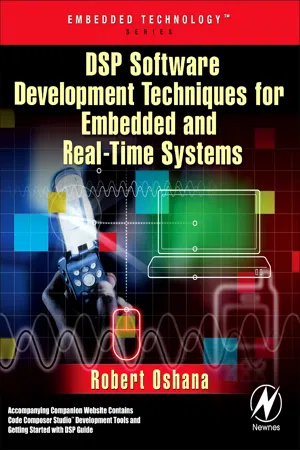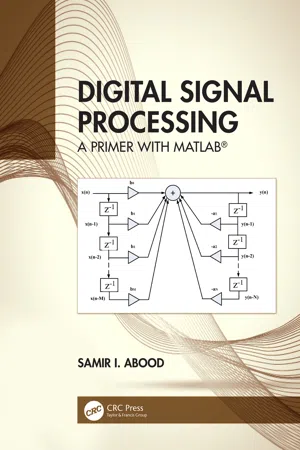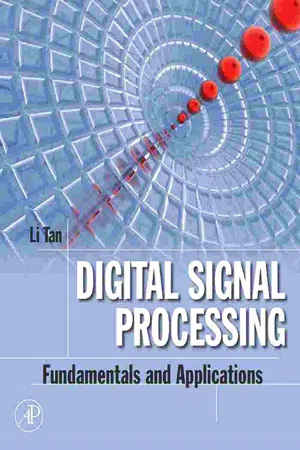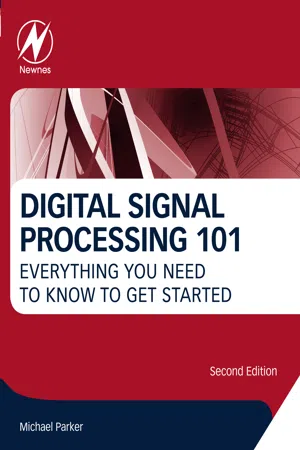Sample Rate
Sample rate refers to the number of samples of audio or video taken per second. In digital audio, it determines the accuracy and quality of the sound. A higher sample rate captures more detail but requires more storage space and processing power. It is a critical parameter in digital signal processing and multimedia applications.
6 Key excerpts on "Sample Rate"
- Robert Oshana(Author)
- 2006(Publication Date)
- Newnes(Publisher)
...When an analog waveform is digitized we are effectively taking continuous “snapshots” of the waveform at intervals. We call this interval the sampling frequency. The samples are stored one after another as binary numbers. When the waveform is reconstructed from the list of sampled numbers, the result will be a “stairstep” approximation of what we started with (Figure 4.5). Figure 4.5 Resultant analog signal reconstructed from the digitized samples When the digitized samples are converted back into voltages, the stair-step approximation is “smoothed” using a filter. This results in the output looking similar to the input. The constraints on sampling are very important because if the sampling frequency, resolution, or both are too low, the reconstructed waveform will be of lower quality. The Sample Rate sets a hard real-time performance requirement for the system. Failing to acquire a sample on time or to produce a result on time has the same effect on the result as a missed calculation in a hard real-time system such as a CD player or cell phone. Therefore the Sample Rate together with the algorithm complexity sets a lower bound for the necessary processor throughput. This can be generalized to: (Number of Instructions to process * Sample Rate) < Fclk * Instructions/cycle (MIPS), where Fclk is the clock frequency of the DSP device. The DSP engineer must understand these constraints early in the development process in order to set the right nonfunctional requirements for timeliness in the system. Timing requirements are a form of nonfunctional requirement. The Nyquist Criteria One of the most important rules of sampling is called the Nyquist Theorem 2. This theorem states that the highest frequency which can be represented accurately is one half of the sampling rate. The Nyquist rate specifies the minimum sampling rate that fully describes a given signal; in other words a sampling rate that enables the signal’s accurate reconstruction from the samples...
- eBook - ePub
Digital Signal Processing
A Primer With MATLAB®
- Samir I. Abood(Author)
- 2020(Publication Date)
- CRC Press(Publisher)
...This includes analog-to-digital conversion (ADC), digital-to-analog conversion (DAC), storage, and transmission. In effect, the system commonly referred to as digitalis is, in fact, a discrete-time, discrete-level analog of a previous electrical analog. While modern systems can be quite subtle in their methods, the primary usefulness of a digital system is the ability to store, retrieve, and transmit signals without any loss of quality. 12.10 Sampling Rate A commonly seen unit of sampling rate is Hz, which stands for Hertz and means “samples per second.” As an example, 48 kHz is 48,000 samples per second. When it is necessary to capture audio covering the entire 20–20,000 Hz range of human hearing, such as when recording music or many types of acoustic events, audio waveforms are typically sampled at 44.1 kHz (CD), 48 kHz, 88.2 kHz, or 96 kHz; the approximately double-rate requirement is a consequence of the Nyquist theorem. Sampling rates higher than about 50 kHz to 60 kHz cannot supply more usable information for human listeners. Early professional audio equipment manufacturers chose sampling rates in the region of 40 to 50 kHz for this reason. The Audio Engineering Society recommends a 48 kHz sampling rate for most applications but gives recognition to 44.1 kHz for Compact Discs (CD) and other consumer uses, 32 kHz for transmission-related applications, and 96 kHz for higher bandwidth or relaxed anti-aliasing filtering. A more complete list of common audio Sample Rates is given in Table 12.1. Problems Table 12.1 Common Audio Sample Rates Sampling rate Use 8,000 Hz Telephone and encrypted walkie-talkie, wireless intercom and wireless microphone transmission; adequate for human speech but without sibilance. 11,025 Hz Audio CDs; PCM, audio analysis. 16,000 Hz Most modern VoIP and VVoIP communication products. 22,050 Hz Audio CDs; PCM, MPEG audio and for audio analysis of low-frequency energy. 32,000 Hz Digital video...
- eBook - ePub
Digital Signal Processing
Fundamentals and Applications
- Li Tan(Author)
- 2007(Publication Date)
- Academic Press(Publisher)
...This process is called sampleandhold. Since there exists one amplitude level for each sampling interval, we can sketch each sample amplitude level at its corresponding sampling time instant shown in Figure 2.2, where 14 samples at their sampling time instants are plotted, each using a vertical bar with a solid circle at its top. For a given sampling interval T, which is defined as the time span between two sample points, the sampling rate is therefore given by For example, if a sampling period is T = 125 microseconds, the sampling rate is determined as f s = 1/125μ s = 8,000 samples per second (Hz). After the analog signal is sampled, we obtain the sampled signal whose amplitude values are taken at the sampling instants, thus the processor is able to handle the sample points. Next, we have to ensure that samples are collected at a rate high enough that the original analog signal can be reconstructed or recovered later. In other words, we are looking for a minimum sampling rate to acquire a complete reconstruction of the analog signal from its sampled version. If an analog signal is not appropriately sampled, aliasing will occur, which causes unwanted signals in the desired frequency band. The sampling theorem guarantees that an analog signal can be in theory perfectly recovered as long as the sampling rate is at least twice as large as the highest-frequency component of the analog signal to be sampled. The condition is described as where f max is the maximum-frequency component of the analog signal to be sampled...
- eBook - ePub
Digital Signal Processing 101
Everything You Need to Know to Get Started
- Michael Parker(Author)
- 2017(Publication Date)
- Newnes(Publisher)
...Chapter 3 Sampling, Aliasing, and Quantization Abstract This chapter reviews the sampling of a signal and its conversion from the analog to the digital domain. Analog to digital converter measures the signal at rapid intervals is called samples, which outputs a digital signal proportional to the amplitude of an analog signal. The chapter throws light on sampling at low and high frequencies, the effects of revolution with time. Nyquist sampling rule is discussed in detail which leads to the elements of quantization. The effect of noise in increasing or decreasing the signal has also been discussed along with the concept of decibels. Decibel is a signal-to-power ratio and expressed logarithmically, which allows chains of circuits to process it. The two types of definition of dB have been discussed with power and amplitude emphasis which is of help to understand the differences in analog and digital signal processing. Keywords Digital signal processing; Nyquist; Quantization; Sampling effects; Signal to noise ratio Now that we have the basic background material covered, let us start talking about digital signal processing (DSP). The starting point to understand is sampling and its affect on the signal of interest. To take an analog signal and convert it to a digital signal, we need to sample the signal using a device called an analog to digital converter (ADC). The ADC will measure the signal at rapid intervals, and these measurements are called samples. It will output a digital signal proportional to the amplitude of the analog signal at that instant. This can be compared to looking at an object with only a strobe light for illumination. You can see the object only when the strobe light flashes. If the object is not moving, then everything looks pretty much the same as if we used a normal, continuous light source. Where things get interesting is when we look at a moving object with the strobe light...
- eBook - ePub
- Udo Zölzer(Author)
- 2022(Publication Date)
- Wiley(Publisher)
...Chapter 3 Sampling Rate Conversion U. Zölzer Several different sampling rates are established for digital audio applications. For broadcasting, professional, and consumer audio, sampling rates of 32, 48, and 44.1 kHz are used, respectively. Moreover, other sampling rates are derived from different frame rates for film and video. In connecting systems with different uncoupled sampling rates, there is a need for sampling rate conversion. In this chapter, synchronous sampling rate conversion with rational factor for coupled clock rates and asynchronous sampling rate conversion will be discussed where the different sampling rates are not synchronized with each other. 3.1 Basics Sampling rate conversion consists of upsampling and downsampling and anti‐imaging and antialiasing filtering [ Cro83, Vai93, Fli00, Opp99 ]. The discrete‐time Fourier transform of the sampled signal with sampling frequency () is given by (3.1) with the Fourier transform of the continuous‐time signal. For ideal sampling, the condition (3.2) holds. 3.1.1 Upsampling and Anti‐Imaging Filtering For upsampling, the signal (3.3) by factor between consecutive samples, zero samples will be included (see Fig. 3.1)...
- Afshin Samani(Author)
- 2019(Publication Date)
- CRC Press(Publisher)
...4 Sampling of Continuous Time Signals So far, I have discussed continuous time signals; however, these days, the use of computers in signal analysis is ubiquitous. Computers enable us to perform very heavy computational processes in a very short time. However, there is one issue here: no matter how fast a computer is, the temporal resolution of recoding and registering the signal is limited. We are simply unable to register the signals such that the signal amplitudes are retrievable for infinitesimal time steps. The questions is whether we really need this? Throughout this chapter, I am going to explain why we do not need this unlimited temporal resolution; instead, we can work with a continuous time signal, given a limited temporal resolution if the continuous time signal is sampled with a fast enough rate. Because we work with a sequence of signal samples, the time axis is no longer continuous. Therefore, we call this sequence of samples a discrete time signal. 4.1 Discrete Time Signals As mentioned earlier, discrete time signals are composed of a sequence of samples of a signal. One could imagine that they are the same as a continuous time signal sampled at equidistance intervals. Thus, for a discrete signal x (n), one can write: x (n) = x c (n. T s) Where xc (t) is an arbitrary continuous time signal, but we have only its corresponding amplitudes at times that are integer multiples of T s (the “sampling period”). To have an intuitive understanding of this, one could imagine that at time 0, we obtain the first sample of x c (t), then T s seconds later we obtain the second sample, then T s seconds later we obtain the third sample and so on. Mathematically speaking, this scenario, after some simplification, corresponds to the multiplication of x c (t) by a series of sharp impulses interspaced with T s. Let us call this an impulse train s (t)...





